Lana Hart's Blog
January 13, 2016
HelloFresh, Week One: A Review
I told y'all it was coming.
Yes, today, we received our first HelloFresh box! In case you didn't read my last blog post and you're wondering what this is all about, let me quickly explain.
HelloFresh is a meal kit company similar to Plated and Blue Apron (and others, I'm sure). It's at least partially run by celebrity chef/nutritionist Jamie Oliver, who I'm a big fan of, and includes boxes of ingredients for 2 - 5 meals per week (the number of servings included varies based on your preferences). You receive fresh ingredients, including meat (if you so choose) and spices, as well as recipes to help you prepare your meals. This is a weekly subscription box and fees range from about $49 to $129 depending on how many servings and how many meals you pick.
For our family, we chose 5 meals per week that will serve 2 people. Our daughter gets lunch and dinner from school, so she typically only wants something small in the evenings. And we figured there will probably be leftovers, regardless. Maybe not much, but enough to sustain her if she's peckish.
Today was the start of our subscription (which, by the way, you can cancel at any time; you can even skip weeks). For the most part... I'm impressed.
My Initial Thoughts
We signed up for recurring Wednesday deliveries. Receiving our meals in the middle of the week works for us, because it ensures that we get through the weekend without resorting to takeout (we seem to be laziest on Saturdays and Sundays). Our main goal is to eat healthier and feel healthier through this program (and save money on groceries in the process). I can't vouch for whether or not HelloFresh meets that goal yet, but the math seems sound.
Anyway, UPS tracking originally said we'd receive our package on Thursday. I freaked out a little because I'd read that some customers were having difficulty receiving their packages on time. I e-mailed HelloFresh and didn't get a prompt response, so I tried calling. The representative who helped me was great and told me Florida routinely has an issue with the tracking showing up wrong, but that she'd check with their logistics team, just in case. A few minutes later, our shipment was confirmed for Wednesday and there was a $10 credit in my account for the inconvenience. Talk about customer service!
UPS Quantum updates later informed me the package would arrive today between 11:30 a.m. and 3:30 p.m. It was at our door by 11:20 a.m. and cold as ice. Some of that can be attributed to the cooler weather here, I'm sure (40s this week! D:), but regardless, the ice packs inside seemed to have done their job.
Two seconds after we set it on our kitchen table, this happened.

Look at that magnificent fuck.
Well, the cats seemed to approve. But it was time to open up the box and see what was inside. With all the ingredients purportedly fresh, I was a little concerned about quality and whether or not they'd end up spoiled.
My fears were soon assuaged... well, mostly.
Part 2: The Unboxening
Talk about organization!
Each box contains the specific ingredients for one recipe, all of which you can pick from on HelloFresh's website. They come in white boxes with labels, so you know what's what. I didn't get a picture of it, but underneath these white boxes are huge packs of Nordic Ice, and beneath those are the meats (if you chose to order any), which are separated from each other in plastic. Not a bad setup.
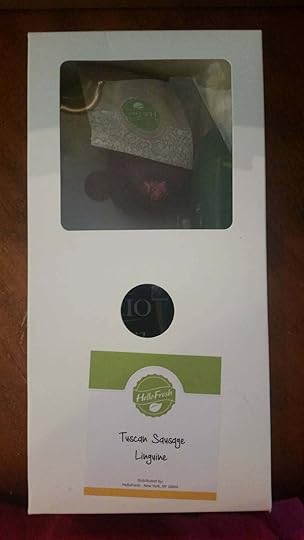
Despite being able to see the ingredients through that little window there, I strongly recommend opening up each box to ensure everything is there, and that none of it is in questionable condition. After investigating each box, we found the arugula for one of our recipes had spoiled. I understand salad greens are prone to moisture, but this was straight-up slime.
Ever played Mass Effect? You know what the Collectors did to their hostages once they were inside those pods? Yeah, that's basically what our arugula looked like.
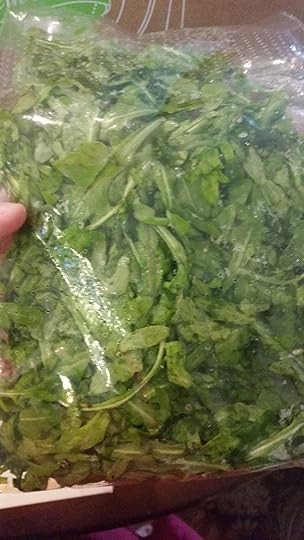
Ugh. Gross.
That was disappointing, because we actually needed arugula for two recipes (chicken Milanese with arugula salad, and some weird sweet potato concoction that I'm not entirely sure about still). Thankfully, there was a second bag in there that hadn't spoiled, but we're still down an ingredient for one recipe.
That being said, all of the remaining produce seems fine, if a little... ugly. Some reviewers have mentioned that sometimes, the vegetables seem like they've been purchased from grocery stores that typically throw out items that look unappetizing, and after this box, I'm tempted to agree. I don't really have an issue with this—the produce, like the sweet potato below, is totally edible and not even remotely close to spoiling—but I do feel a niggling sensation of annoyance that we're paying $99/week while receiving bargain bin items. Part of the allure of HelloFresh is that we won't have to go to the grocery store very much anymore, since they'll do the produce shopping for us. Only if it was me who was doing the shopping, I wouldn't have picked a sweet potato that looks as if it's been partially peeled already. When your company is justifying their prices with lines like, "we'll do your shopping for you," I would expect a higher quality.
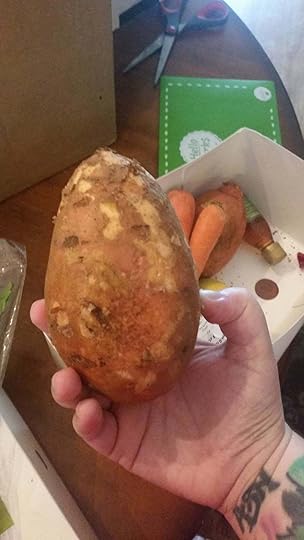
Allow me to say it again, though: there's nothing wrong with this, freshness-wise. It's just ugly as sin and it irks me, given the amount we've paid for this service.
Everything else was in good condition. I really can't complain. The meats, in particular, looked fantastic. And to my surprise, the shrimp was shipped fresh, not frozen. It was also already peeled and deveined, which saves us some work. Additionally, though I didn't get a picture of it (sorry!), the butternut squash one recipe calls for had already been chopped. This made Ryan pretty happy, since he hates chopping squash.
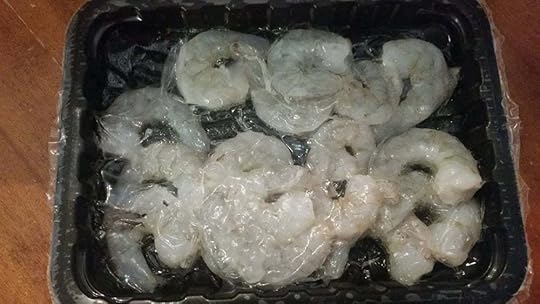
When checked for freshness, there was hardly any smell and their color looks great. A note attached to one of the white boxes told us we should make the shrimp meal first, and I agree. I was glad they mentioned it, because it's hard for me to keep track of when certain foods are past their prime, and it would be a shame if this went bad.
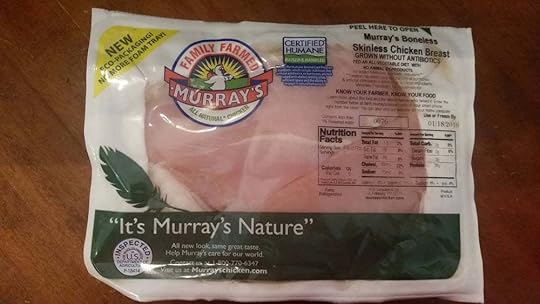
Likewise, the chicken looks great. We took it out of its package to freeze it, since we likely won't be eating it for a couple days, and there was no strong smell and the color was good.

And who can forget about the steak? I certainly can't. It looks amazing. As someone with anemia, I enjoy the occasional steak. I'm really looking forward to making this tomorrow.
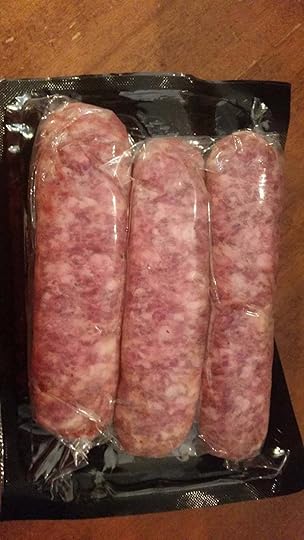
Sausages! I love sausages. And these look great. Good color, no noticeable odor. Looks exactly like what I'd get from the store.
In addition to the food, you get a recipe book. What's neat about the booklet is that you can easily tear the recipes out along the perforated line, or you can leave them in. It's your choice! And of course, since you're making the food yourself, you can reuse the recipes any time you like, even if your meal kit doesn't include them on the week you've got a craving.
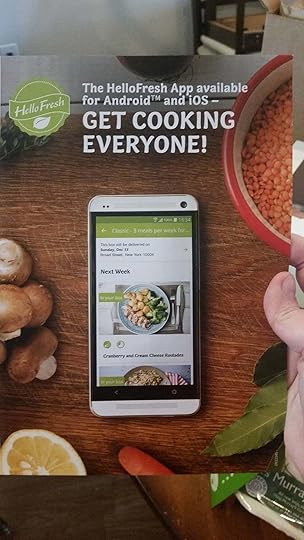

Tomorrow night's dinner. It looks amazing.
Final Thoughts
We haven't made any of the recipes yet, so it's hard to say if we're totally satisfied with HelloFresh yet, or not. So far, so good. All but one item arrived fresh, as their name would suggest, and I'm happy with all but one meal choice (I learned later that you can sub out options BETWEEN boxes—i.e., we could've subbed a meal from the Classic Box for one of the meals from the Veggie Box—so this shouldn't be a problem in the future), so I have high hopes. I'll update again once we've had the opportunity to try all the recipes, see how filling they are, how flavorful they are, and if it actually impacts our grocery bill or not.
One thing I want to quickly mention: I've seen a lot of complaints about portion sizes not being big enough. I will probably disagree with that. In America, we have a huge (no pun intended) issue with oversized portions, and I think that criticism is coming mainly from people who are used to our tendency to overeat. I don't think having smaller portions is a bad thing, since one of HelloFresh's aims is to make people healthier, although I realize that one's mileage may vary if they're serving up meals to kids or teens.
As of right now, HelloFresh seems worth it. Especially if you're health-conscious or just sick of going to the grocery store for hours at a time. I've had great experiences with their customer service and as of this blog post, I'm interested in continuing with their program.
If you're interested in trying HelloFresh for yourself, use this PROMO CODE for $40 off your first box! The best part is that to my knowledge, it doesn't expire: 2P8E8P
(Full disclosure: using that code means I get $20 off my next box, too, so while I could get something out of the deal if you sign up, that has not affected my review. I would never recommend something I don't believe in, and if you'd rather wait until I update my blog with details of how the week went, that's fine too. I was not sent anything for free or at a reduced rate for this review. Trust me, guys... I'm not popular enough to warrant that kind of treatment yet!)
I just found out my next Try the World box (Thailand) should be here Friday, so you can expect more updates from me then! I got the Paris Box yesterday, so I'll be reviewing both at the same time, and I may even have some writing news for you guys. Be sure to check back with me soon!

January 12, 2016
A New Year's Resolution
I really don't take much stock in New Year's resolutions. They're prone to failure for a variety of reasons, not least of all: who can predict what trials and tribulations we may run into throughout the year?
But I did make a promise right around January 1st that I was going take better care of myself. I was going to spend quality time on me. Going to allow myself some simple pleasures. Get back to a lifestyle that nourishes me.
In short... I was going to treat myself.
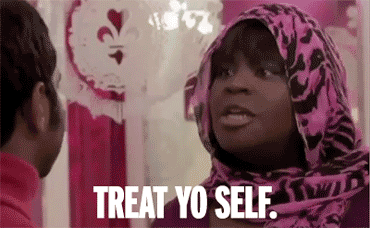
One of the reasons I'd stopped caring for myself properly in the past was money. So I knew that if I was going to treat myself, I was going to have to cut some costs, or find something that was cost-effective.
That's when I discovered subscription boxes.
No, I haven't been living under a rock. I'd heard of subscription boxes before, but it was always toys or soaps, nothing that I felt was both practical and entertaining. But just in time for the holidays, I found out about two subscription boxes I want to talk about today: Try the World and HelloFresh.
First, we'll talk about Try the World.
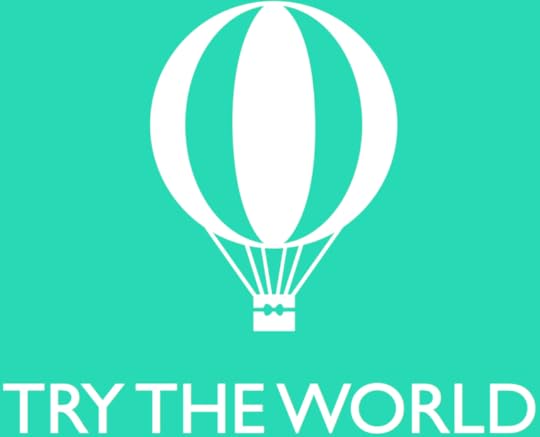
Try the World is a subscription box filled with goodies from various countries around the world. For $39 every two months, you get a beautiful box and 7 - 8 items from France, Italy, Spain, Thailand, Japan, Argentina, and a variety of other nations. Your treats may vary—for instance, the Holiday Box (the first box I ordered) could have contained either hazelnut cream or pistachio cream. I got the hazelnut cream, which I was kind of disappointed about until I tried it on top of some Swiss ginger snaps. OMG, PERFECTION.
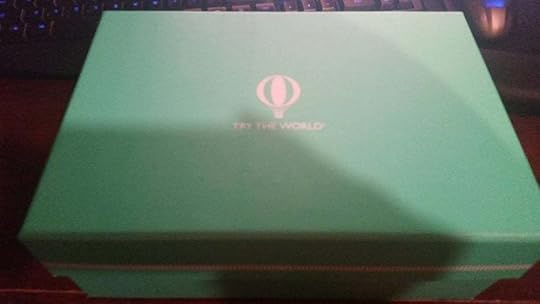
Please excuse the lighting here. I was in my office, and the track lighting bulbs go out about once a month, and we haven't replaced this month's outages yet.
The reason I decided to experiment with Try the World is because I LOVE FOOD. I'm a true Gemini, easily bored by the banal, always seeking out new experiences—and that goes double for anything culinary. I'm also fascinated by the idea of travel, but since I'm not rolling in dough quite yet, this is sort of a way for me to visit other countries without the massive expense.
Plus, they were doing a deal where you got two boxes for the price of one, PLUS a coupon for 15% off. Um, yes, please.
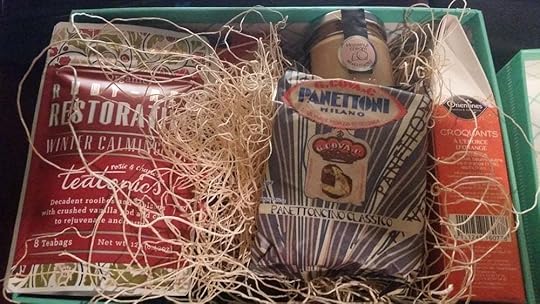
Inside: nummy goodness and little, wispy, straw things I got way too excited about.
My first box, the Holiday Box, arrived within about 10 business days after I placed my order. Everything arrived intact, and the goodies consisted of: a sweet loaf from Milan; tea from the UK; orange peel cookies from Morocco; hazelnut cream from France; Acai dessert sauce from Brazil; chocolate truffles from Canada; olive oil from Israel; and Swiss ginger snaps.
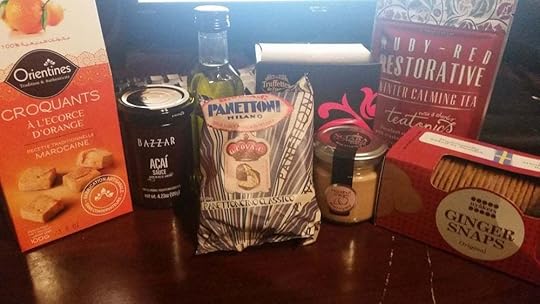
From left to right: orange peel cookies, dessert sauce, olive oil, sweet loaf, chocolate truffles, hazelnut cream, tea, and ginger snaps (duh).
I loved that each individually packaged morsel wasn't just wrapped in plastic or tin foil, or otherwise looked generic. I felt like I could have walked into a shop in any of these countries and seen one of these products on the shelves. It brought a little ray of sunshine to an otherwise dreary month.
On top of that, you get a neat little guide that tells you more about the items in the box, including suggestions on how to use them, as well as recipes.

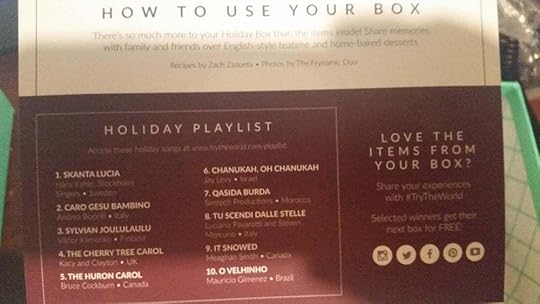
Of course, being the impatient child that I am, I just had to try everything right away. I was not disappointed. The hazelnut spread and ginger snaps were amazing. I'm a huge fan of ginger snaps to begin with, but I figured they'd be like the kind I pick up here at the store. WRONG. They were way better, with a crisper bite to them that went really well with the sweetness of the spread. The orange peel cookies were more savory than sweet, but still delicious; the cocoa truffles were out of this world (not as sweet as expected, but that's not at all a bad thing); the sweet loaf was gone in an instant (mostly the work of my daughter); the tea was very soothing; and I'm looking forward to glazing either a turkey breast, or a whole chicken, with some of that Acai sauce.
As for the olive oil... well, it's olive oil. But it's always good to have some of that around!
Did I feel like I got enough bang for my buck? Well, yes and no. On one hand, I probably could have found similar products myself at World Market, or some other place. But the World Market closest to me is in Sanford, which is quite a distance, and would be super inconvenient to go to. $40 is a lot for eight items, but knowing they came from places I'm dying to see, and in such pretty packaging too, softened the blow. The next box I receive will be the Paris Box, which I'm eager to tell you all about. But first, let's talk about HelloFresh.
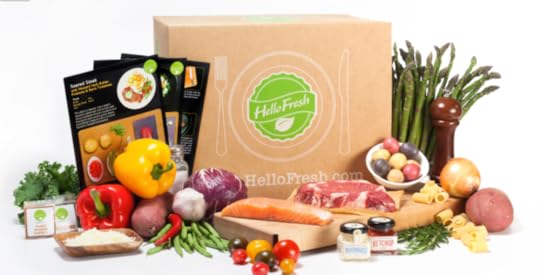
HelloFresh is a grocery delivery service affiliated with celebrity chef/nutritionist Jamie Oliver. I've been a fan of his for quite some time, and knowing I wouldn't have to go to the grocery store except for a few staples really appealed to me. There are a variety of plans you can choose from: the Classic Box, where you can order two meals for two people, three meals for two people, four meals for two people, or five meals for two people; the Veggie Box, which is like the Classic Box, except vegetarian; and the Family Box, where each meal serves three to four people.
The best part is that HelloFresh had the foresight to design these groceries around specific recipes, which are included in the box. Not only that, but absolutely everything you need (minus cooking utensils and oil) is packed right in there. Oh, that recipe calls for oregano? Great! You've got a packet of oregano inside. It's a fish recipe? The fish is included, too!
And you can swap recipes out if, say, you have an allergy, or if you'd just prefer one from another box. I'm all about variety, so that really seems like it will work for me.
I'm supposed to receive my first HelloFresh shipment tomorrow, so I'll update then and let you know how it went. I've read some complaints about the freshness of the foods (ironic), but I'm feeling very positive going into this. It may even be less expensive than what we spend on groceries now, which makes it a very practical way to treat myself.
I haven't been paid by anyone, or received anything free, for these reviews. This is all me. So if you're wondering about how genuine this is, never fear—I will always give my honest opinion on a subject. Especially when it comes to food. So far, I think Try the World is definitely worth trying. Time will tell on HelloFresh, but I'll be sure to post more when we receive our first box.
Do you guys have any indulgences you'd like to share? How about a subscription box you absolutely love? Let me know in the comments! I'm always looking to try new things and would love some recommendations.
And if you're interested in trying the world, click here for a coupon for $15 off your first box!
November 12, 2015
Anxiety and Depression Make Terrible Writing Companions
"It's fine," I say for the millionth time as I stare at my barely begun manuscript. "You're doing fine."
But it doesn't feel fine, and that's why I've written a paltry 4,000 words rather than the 50,000 - 75,000 I ought to be at by now.
The trouble is, regardless of how often I assure myself otherwise, I'm not sure whether or not what I've written thus far is any good. When my anxiety and depression come to call, I lose all perspective, all objectivity. When the symptoms of these diseases often include dissociation and feelings of despair, is it any wonder I can't determine which of my writer senses are telling the truth, and which are hampered by pessimistic muck?
If optimistic people are seeing the world through rose-tinted glasses, I am seeing everything through a thick, gray filter. I don't think blue is the right color for it. I'm not particularly sad, really. I'm confused. I'm trying to identify the differences and nuances between the things I'm seeing, but I can't, because everything is just the same solemn shade.
I could be holding a yellow ball and a red ball, but I'd never know, because they both look gray.
And because everything looks the same, because I can't tell the difference between anything, my characters feel the same to me, as well. Even though they should be different, Jareth and Talia feel like they're cut from the exact same cloth. Piotr doesn't seem as lively as he did to me before. Arghest's dialogue might as well be Talia's. Jareth, rather than coming off as strong, principled, and just a little overwhelmed with his burden, seems far too gruff. Two-dimensional. The typical "alpha" stock character. Talia, rather than curious, capable, and roguish, comes off merely smarmy and bratty, a River Song-like combination that I absolutely abhor.
Or at least, that's what I think. I don't know for sure. Is it because of my anxiety and depression that I feel this way? Or am I actually writing these characters poorly?
It could be either, because no matter how many times I rewrite these scenes, I feel dissatisfied with them. I feel distant, disconnected. I feel like I'm not getting to the heart of this story, no matter how many times I plunge in my pen. It just isn't working.
I could stop writing. I could give myself a break, a breather, a mini-vacation away from this story so I can better collect my thoughts. But then it won't get published on time, and I'll ultimately lose out on potential income that I need to care for my family.
I could push on, but then the story might suffer. The characters might, indeed, come off as disingenuous.
Without perspective, I have no way of knowing what the right choice is. For you, it might be as clear as black and white. But for me, now, as a writer used to painting a Technicolor world, everything I write, everything I see and do, exists only in indistinguishable shades of gray.
October 6, 2015
A New and Curious Opportunity
Hey, curios!
I love bringing to life some of the scariest, most magical, and somehow romantic stories you've ever read. I have so much left to tell you about the world I've created—some real juicy, terrifying stuff.
And this is where you come in.
I'm a full-time author and editor, and though I want to focus more on bringing you the kind of stories you crave—the stories you deserve—I'd have to take less outside work in order to make that happen. I have a scary little girl to feed, so the only way I can manage is if you donate your hard-earned dollars to keep me churning out all this delicious content I've got holed up in my brain.
If you fund me on a monthly basis, I can promise you a short story that will chill your bones, excite your imagination, and thrill you to the core. They'll all take place in Sanctum Harbor, and fans of my series may even see some familiar faces featured in these tales of terror.
Basically, you'll be sponsoring a cursed object every time you donate. And in return, you'll get to hold it for a little while, learn its history, and find out exactly why it's so dangerous.
What are you waiting for? Don't you want to see what happens next? Pledge today and get first dibs on a brand new glimpse into the horrifying, intriguing, and mysterious world of Sanctum Harbor.
Just click here to become a patron. You choose the level. You choose the rewards. It's that simple!
September 30, 2015
RELEASE DAY: The Bejeweled Bottle is Here!
Surprise, curios!
The Bejeweled Bottle is here!
After a long wait, it's finally arrived: the third installment in the Curious Collectibles Series!
Right now, The Bejeweled Bottle is on sale for $0.99 and FREE for Kindle Unlimited subscribers. In fact, the whole series is on sale with updated content and new covers!
If you've already read The Magic Mirror and The Spellbound Spirit, but would like the new content, Amazon should allow you to sync the newest versions to your eReader. Failing that, reply to this e-mail and let me know you'd like the new editions, and I'll send you some copies!
One thing I can't stress enough: I am DYING to know what you think! If you were an ARC reader, now is the time to leave a review. If you're getting The Bejeweled Bottle today, leave it at your leisure on Amazon or Goodreads (or both!). You can even e-mail me directly to let me know your thoughts. I'm always open to reader feedback and input (and even fanfiction, which I'm told is coming soon).
I cannot wait to share this story with you, so one-click now and get ready for a tale of adventure, mystery, horror, and of course, romance!

July 4, 2015
An Addendum, a Call to Arms, and Also, WTF, Scribd?
All right, so in my previous post, I came out swinging at Hugh Howey.
I want to make something clear: I do not endorse, condone, or encourage the harassment of anyone. Especially not another author.
Hugh said some messed up things. He was smug, condescending, and rude. I don't know why. Maybe he's forgotten where he came from. It happens.
Everyone makes mistakes. And if he stops acting like a jerk, I'll be happy to forgive him for it. The point of my previous blog post was to let you guys know what was going on and to call Hugh out since he's always been a huge part of the indie publishing community. I don't hate him. But I do think he's being wildly dishonest with us, and an elitist, to boot.
Now, let's move on to other things: Happy Independence Day!
And for some authors, happy independence from Scribd day?
Earlier this month, I got an e-mail from Draft2Digital. For those of you who don't know, D2D is a digital publishing and distribution service. A one-stop shop for indies, if you will. Want to publish to multiple platforms but don't want to go through the hassle of making an account with each of them? You're in luck! D2D takes care of that on your behalf. Upload the files, send 'em out, and bam—you're done.
I'm a perfectionist and micro-manager, so largely, I didn't use this service. The only title I have on there is The Magic Mirror because otherwise, Amazon wouldn't price-match it to free (this is another issue I have with them, but let's table that for now).
Usually the e-mails I get from D2D aren't anything I need to worry about. Maybe they're letting me know I once again made nothing from a free title this month. Or it's a privacy policy update. No big deal.
This one, though...
As we all know, the concept of a subscription service for books is extremely new. There are several models on the market now for effectively monetizing subscriptions, and none of them exactly matches what we’re used to from traditional sales royalties. As the market experiments with different approaches, there are bound to be some missteps and false starts along the way. In fact, we should expect this business model to evolve even more in the near future.
Scribd took a significant risk putting in place a model that paid authors the same amount as a retail model for each book read by a subscriber. As we all know, romance readers tend to be incredibly avid readers. In trying to cater to this voracious readership while under this progressive payment model, Scribd has put itself in a difficult place. In a bid to better balance these operating expenses, Scribd is immediately slashing the volume of romance novels in its subscription service.
If you are receiving this email, then you are a Draft2Digital author who has published books in the romance genre to Scribd. This means that some or all of your romance novels are likely going to be delisted from their service today. (Books that are priced at free will not be removed.)
While a large number of romance novels will be removed from Scribd, it isn’t all of them. We aren’t privy to the exact guidelines Scribd is using to decide which romance novels will remain, and it’s our understanding that they remain in flux at Scribd. However, over the coming days, we will be working closely with Scribd to resolve the exact criteria and share them with you so that you’ll have the opportunity to restore all of your titles to the service.
Please Note: If you write in other genres, understand that those books will not be affected by this policy change.
We apologize for any inconvenience this may cause and assure you that we are working with Scribd to explore alternative solutions to this challenging problem, always searching for new terms that could restore our full catalog to their service.
Believe me, this situation is just as difficult for Draft2Digital as it is for you. We also stand to lose a significant portion of our revenue due to this change. More importantly, we regret that we couldn’t give our authors more notice, but unfortunately we were informed quite late in Scribd’s decision-making process. It has been our highest priority throughout these discussions to preserve as many of your books in the service as possible, and we will continue to pursue that goal going forward.
If you have any further questions or concerns, please don’t hesitate to contact us.
— Kris Austin, CEO of Draft2Digital
In case you need me to sum up, basically what happened is this:
Scribd adopted a similar subscription model to Amazon's Kindle Unlimited.Scribd didn't realize that romance authors were so prolific or successful.Scribd realized romance was selling faster than any other genre, thus necessitating a very high payout to romance authors.Scribd decided this was unfair to other authors (and themselves—who knew they'd actually have to pay these people?) and completely removed the entire romance genre from its program.So, when I say, "WTF, Scribd?" that's what I mean: that once again, erotica and romance authors are getting hit hard by a company's desire to "redistribute earnings" in the name of "fairness."
Why are we being punished for writing what readers love? Who the hell knows. My guess, based on what I've seen on various forums, is that authors of other genres are complaining. A lot of people dog romance and erotica as genres for several reasons, one of which (that should come as no surprise to anyone) is that women dominate the field. These are really the only genres where writing with a female pen name is encouraged. For fantasy and sci-fi especially, female authors are often encouraged to use male nom-de-plumes to avoid getting snubbed by male readers.
So, largely, the bias is pure and utter sexism. Simple as that. Sort of like how horror is considered a "male genre" even though it was literally invented by women (Mary Shelley, notably). Same for science-fiction novels, which were pioneered by... you guessed it... women.
But now we look at romance and erotica as lesser-than. Stupid. Superficial. We roll our eyes and smugly grin and say it's not real literature (as though the A Song of Ice and Fire series is). Women authors are considered flighty and shallow and incapable of telling real stories. And when the genre does well, we chalk it up to "stupid women readers."
This is absurd for so many reasons, but I'll list just one for now: pretty much any medium you consume that isn't a Michael Bay film has a romantic element to it, even if it's just an undercurrent. The romance options in Mass Effect are exploited just as much by male players as they are by females. Japanese dating sims are extremely popular. Brandon Sanderson plays with romance in his very popular fantasy novels. And when a writer doesn't do romance or sex well, they're often made fun of for it.
So if we're ready to value writing romance and erotic scenes as requiring some modicum of talent, why can't we extend that thinking to... oh, I don't know... an entire genre that requires that talent to be successful?
Mostly, because it's written predominantly by women. And sadly, there is still a stigma attached to being a woman, being a woman who writes, and especially being a woman who writes erotica and romance.
But I digress. The point is that I'm seeing a real problem with these subscription-based programs, and it is this: other authors whinging that their work isn't holding up against romance and erotica.
This is the problem I had with Hugh Howey. And this is what I'd like to address.
Writing is hard fucking work. It is back-breaking. Soul-crushing. No matter what genre you are writing it, it takes a certain level of skill. Talent. Practice and research. And as indie authors, we don't have anyone paying out advances or looking out for us. We don't have promo teams. We don't have in-house editors. We spend time and money to educate ourselves, to hire editors, cover designers, and much more. Our struggle is unique. Even in 2015, we are still fighting to be seen as real authors.
So why the fuck are we turning against each other? Why are we replicating the same elitist hierarchy that exists in the traditional publishing industry? We are the most vulnerable authors in the entire industry, people. We need to stick together. Stick up for one another.
We have enough enemies already. We need to make ourselves allies.
We are the only ones who can stop what is happening to us. We are the only ones who can demand better of our publishing partners. We cannot do that if we're looking down our noses at certain genres. We cannot do that if we consider a certain subset of authors who work just as hard as we do "non-deserving outliers."
We have to be brothers and sisters. We have to bargain for our collective interests. It is Amazon's and Scribd's wet dream that we keep up the infighting and don't stand as one on this, because then they never have to address the greater issue: paying authors rightly, fairly, and treating them as legitimate artists who will not be taken advantage of.
The only way that works is if we join hands and stop pretending there isn't enough money to benefit us all. If your work is not popular, it's not because other writers have stolen something from you. It is because you need to work on something. Marketing. Writing. Editing. Perhaps you need to do a little market research and jump on trends when they're fresh and lucrative. Perhaps you might even have to write a little erotica or romance to fund your more precious works.
In short, you have to give readers what they want.
And tearing other authors down or slashing their profits is not the way to do it.
Because you know what? Someday, that subset of authors could be you. Once these companies see it's okay to do to one group, you can be sure they'll do it to the next.
And by that time, you'll have alienated everyone around you. You'll have no one to speak up on your behalf anymore.
This, not my last post, is a call to arms. It's a call for authors to stop dogging each other and focus on the big picture: how can we thrive in a system that can readily and easily take advantage of us?
Stand together. Embrace the spirit of Independence Day.
Let's make this a fantastic job for everyone.
July 2, 2015
It Just Keeps Getting Worse—KU 2.0 to Pay Authors Half a Penny Per Page Read
Well, as of July 1st, indie authors everywhere know that the Kindle Unlimited situation is way worse than it seemed.
In my previous blog post, I estimated $0.01/page would be paid out under Amazon's new pay-per-page-read scheme. For those of you just tuning in, Amazon will now pay authors in the Kindle Unlimited program per page actually read by the reader. This means if a reader doesn't read some of your book, you don't get paid for it. This model hardly seems fair when, as we all know, it is employed literally nowhere else. You can't exactly pay only part of your Netflix subscription if you don't use it to its fullest extent.
Well, as it turns out, my estimate was a little too generous. We now know that Amazon will only pay out $0.005 per page read across the board.
Half a penny per page read.
I'll let that sink in for a moment.
We got this number from the data they sent us in a recent e-mail, wherein they told us that in June, there had been 1.9B pages read and $11M in the Global Fund from which we get paid. $11M/1.9B = 0.0057, so if you're feeling generous, we're getting about $0.006 a page.
Given that per Kobo's recent study, the average rate of completion on a novel is roughly 60%, a 300-page book would earn about $1.02 per borrow, way less than the $1.35 we were all getting before.
How did this happen? you might be asking. Who the hell signed off on this?!
Well, Hugh Howey did, for one.
Back in September of 2014, Hugh went on a podcast and hailed the idea of "paying a fraction of a penny per page" in the Kindle Unlimited program (1:07:24, for those of you who want to skip right to it). On June 30th, he made a blog post calling concerned authors "hysterical" for not buying into the hype, and Tweeting that the new program would be "profitable, even for short story authors." On July 1st, he refused to comment on the half a penny per-page-read rate, and on July 2nd, he released a new blog post with the ever-so-charming quote:
It doesn’t take as long to write a short story. You shouldn’t get paid as much. End of (short) story.
— Hugh Howey
Just a reminder that this is the guy who made millions off of 15,000-word short stories. Now, apparently, the rest of us are...
...well, I'll let some other quotes from him tell the story.
"The only people who won't profit from this are non-deserving outliers."
So the vast majority of authors enrolled in the program, then?
"...short works are how I quit my day job and made a living as a writer."
That's exactly why so many of them are angry. They won't be able to do that anymore.
"...maybe short story writers shouldn't have quit their day jobs."
So you're gloating about how you were able to do it, but the rest of us are stupid for having done so?
"I just think their outrage has no ethical foundation ... their outrage is based on greed. I'm highlighting that."
Right. Because us parents and veterans and disabled folk are so greedy for wanting to feed our families, am I right?
I tired to get Hugh to clarify his position via Twitter, but that resulted in him blocking me and then taking to Facebook to cry to his fans about how he'd been "attacked." Below you will find images of the tweets I sent to him, or otherwise had him tagged in.
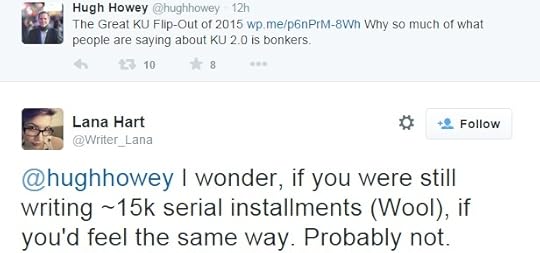
The shock!
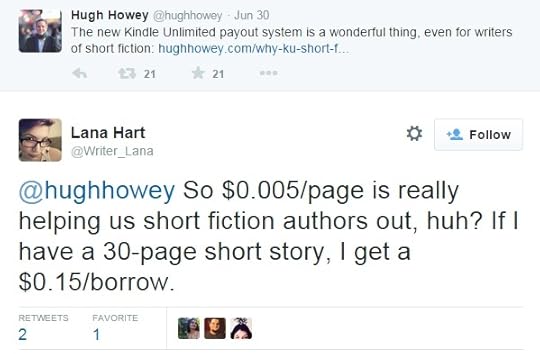
The horror!
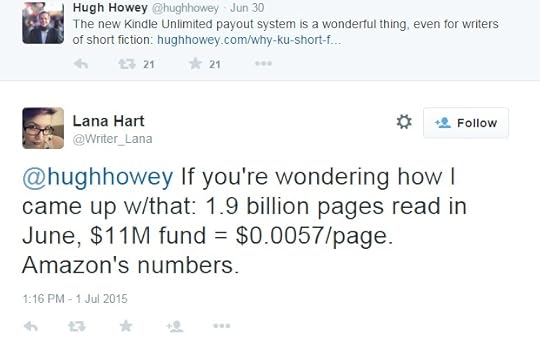
Oh, the humanity!
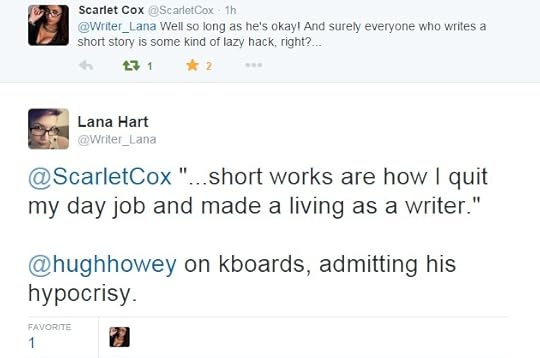
Given how rude he was in his blog posts, I didn't find this one overly harsh.
And finally...
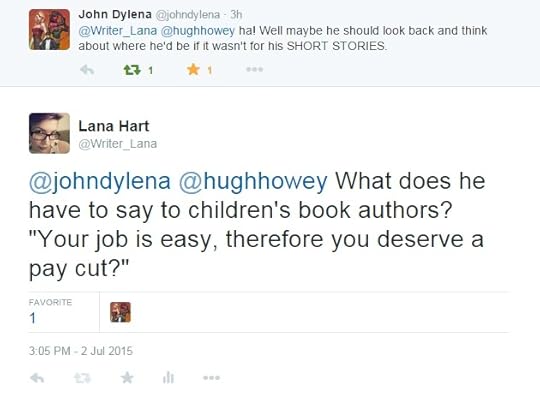
How is this not a legitimate question?
That last point is something in particular I'd like to touch on. Short erotica authors, or short horror authors, or what-have-you are not the only ones who will suffer from this. Authors of children's books and cookbooks and reference manuals will all see a significant decrease in pay because of KU 2.0.
Yet Hugh Howey says we're all Chicken Little. Yes, he goes so far as to denigrate us this way.
"With only one month of information, you couldn't possibly know how the future will turn out," he writes.
Well... we can make some pretty good estimates.
In this fantastic and comprehensive blog post, M. Keep explains how we can extrapolate from an entire year's worth of KU data what we'll see in July and in the fall months.
To quote:
If this change had gone live in June, Amazon has given us the following information:
Base Fund: 11 Million
Pages Read: 1.9 Billion
Average pages per borrow: 210 (I got this number by taking the estimated borrows for June given the typical growth rate, and dividing it by the number of pages Amazon has released)
From this calculation, you can easily find for yourself that in June, we would have been paid $0.0057 per page, and some novelist may be clapping with glee.
So let’s look at July. Given the growth of the fund, and the growth of the borrows, we can estimate the following:
Fund: 13.7 Million
Borrows: 10,261,113
Average pages read: 2.4 billion
Average pages per book: 210
Payout: 0.0057
That's the exact same rate as the rate for June. And the average pages read number is only going to go up from here. Summer is not the season for reading. The fall and winter is when we'll see more pages read.
So unless Amazon is willing to funnel tens of millions more into this Global Fund, our rate of pay can only go down from here.
"But," some novelists are saying, "our books are still getting more money, which is great, because before, short stories were getting paid the same as us, and that just wasn't fair!"
Congratulations. You're making a whopping $0.30 more per borrow than you were before, assuming a 100% completion rate. If it's only 60% read through, you're earning considerably less than you were before.
And mind you, you are earning that $0.30 at the expense of short story authors earning over $1 less than they were before, so if you're interested in fairness, how, exactly, is this a solution?
What it seems to boil down to, for many authors, is an issue of "deserves." Short story authors didn't deserve to make thousands of dollars. Short story authors didn't deserve to make as much as I did. "Poor quality" doesn't deserve as much as "good quality."
Make no mistake that when you hear someone spouting this tripe, what they're actually saying is: "Erotica is not a legitimate form of writing because I'm mad that people would rather read stroke fiction than my 500-page fantasy novel which is actually just a metaphor for getting out of the friendzone."
Not only is that impossibly elitist, I'd wager it's sexist, as well. After all, erotica is written primarily by women for women, and the only other genre you can say that about is probably romance... which gets denigrated just as often in terms of "quality."
Which, I'd add, is a completely subjective metric and should not be used to determine what an author gets paid.
Because the fact of the matter is that the market ought to decide that. Readers ought to decide what is "quality" to them, not a bunch of butthurt novelists who can't see the forest for the trees. That is, in fact, how the system has worked for ages. Fifty Shades, is, in my opinion, terribly written and irresponsible in its romanticizing of intimate partner violence, but that doesn't mean I think E.L. James ought to be paid less for her work. Let her audience decide that.
Which is why the market for short stories continues to thrive on the side of readers actually reading that work. Unfortunately, in this new pay-per-pages-read scheme, that market is no longer viable for authors to write in.
Consider that with the new KENPC standards, your previously 30-page story may now be about 40 pages. If a reader consumes the whole thing, you'll $0.22 per borrow. If not, you'll get substantially less.
If you're hiring an editor (which you should), paying for a cover, and paying for advertising, you may pay an upfront cost to publish. For a short, let's say that's $3/page (based on a novelist on Twitter quoting her per-page average as $8/page). 3 x 30 (the originally, pre-KENPC number, for fairness' sake) = $90 you've paid to produce this book, not to mention all the hard work you've put into it. In order to break even on this title, how many borrows would you need?
KU 1.0: ~67
KU 2.0: ~409
With that kind of discrepancy, it's no wonder that authors are no longer willing to write short stories, despite how many readers would like to read them.
But Lana, you say, KU is an opt-in program. They can just take their books out and have people buy them on other platforms, from now on!
First and foremost, leaving KU has a major impact on visibility. Amazon counted "borrows" as sales, so once those are gone, expect your book to tank.
And secondly, as I pointed out about a year ago, KU has allowed Amazon to pretty much corner the market on eBook sales. So distributing on Amazon, Barnes & Noble, and Smashwords, for instance, will likely hurt your sales as well, since the latter two vendors don't get nearly as much traffic (and since your rank on Amazon has dropped like a stone, no one is going to see your book).
Just like I predicted, indie authors are trapped between a rock and a hard place.
But there is hope.
On Twitter and Facebook, #releasetherate is working on trending. This campaign comes largely from Selena Kitt's efforts to force Amazon to be transparent about what we're making. #paytheartist is another great hashtag to bring awareness to the issue of half a penny per page just not cutting it. Any way you cut it, it simply isn't fair to anyone.
And just so we're all clear, I'm not the kind of person who screams about problems without having prepared a few solutions.
So, Amazon, if you're reading, I'll give you a payment plan that would have been fairer, and yet lucrative for everyone involved. It would have attracted high-quality authors to your program and rewarded them for their effort. Likewise, it would have continued to reward short story authors for giving their audiences what they wanted, too.
Here it is.
LANA HART'S KINDLE UNLIMITED PAYOUT PLAN
Use the current KENPC (which is basically an algorithm designed to standardize page count, using pre-set parameters) tool to actually standardize page counts with a correlation to word count. For the sake of argument, we'll call 5,000 words 20 pages.Use this metric to assign borrow values. Ex.: 20 - 50 pages, $1.00; 51 - 100 pages, $1.10. 101 - 200 pages, $1.20. 200+ pages, $1.30. As long as they are read past the 10% mark, it counts (since on Amazon's site readers can read up to 20% of a book they're interested in for free, I have no problem with this number).EVERYBODY WINS. We all know you were trying to normalize the borrow rate at about $1.30 per anyway, so there you go—only the upper tier gets it.I've already addressed this issue on Twitter, but a few people have voiced concerns that this would just lead some authors to pad out their books for the higher tiers of pay, to which one can only reply: wasn't literally everyone doing that already? And didn't readers do a phenomenal job of not buying books they weren't interested in when authors did that?
I offer this to you, Amazon, completely free of charge. Just implement it soon and get rid of this unethical, unprofitable nightmare and we'll call it even.
Next time on Lana's blog, we'll be discussing how Scribd literally kicked out romance authors from its program from... wait for it... selling too many books. Until then, I'll just hope I didn't make Hugh Howey cry too hard by asking him legitimate questions.
June 21, 2015
Getting Paid by the Page (Or, I Told You So)
If you've been on my blog for any length of time, you've seen the many, many posts I've made where I criticize Amazon's Kindle Unlimited plan.
First it was because borrows, which work the same as sales, were going to pay out far less than "actual sales" as far as royalties go ($1.80/borrow vs. $2+/sale).
Then it was because Amazon absolutely refused to tell us how much we were getting paid per borrow. The number would fluctuate month-by-month, and not only that, but Amazon wouldn't let us know what that number was until the 15th of the following month.
Then it was because borrows tanked month after month, going from $1.80 to $1.35.
I said a lot of things over the past year. Things like, "this is how frogs boil." Things like, "if self-published authors don't stand up and demand better, they are going to feed into a system that sees their complacency and tries to screw them over even more."
A lot of people said I was wrong. That I was paranoid. That I didn't know what I was talking about. Surely, Mother Amazon wouldn't do this. They're fine operating at a loss, these people said. They're looking out for the little guy, and that's us!
So, what has Amazon done for the little guy now, you ask? Well, they've decided that they're going to pay us per page read, not per book borrowed!
Yes, you are reading that absolutely insane idea right. From July 1st on, Amazon will only pay authors a certain number per page read. So no longer will we earn our $1.35/borrow. We'll earn $0.01 or so per page the reader actually looks at. So if someone borrows your book, but doesn't read it all the way through, congratulations! You're going to get paid pennies!
Oh, and did I mention that Amazon hasn't actually settled on a number per page yet? And they won't. They'll let us know the 15th of August what number they've come up with. And just like the KU that exists now, that number may vary at Amazon's discretion.
This means a few things, besides the obvious.
Short stories will no longer have a market. If your short story clocks in at 20 pages, you'll get paid $0.20 per borrow or less, assuming the reader actually finishes it. And nobody wants to write that. Remember all those erotic shorts you used to get for free because they were enrolled in Kindle Unlimited? Kiss those goodbye!Novels will be the only lucrative medium to write in. So if you enjoyed novellas, serials, or anything other than long-form novels, I'm sorry to say your options will be limited from now on.As such, you can expect some really terrible novels, and some really long wait times between stories from your favorite authors. Expect to see a bunch of really awful novels by authors who were really better suited for short stories and the like. And then, once those authors realize nobody is finishing those, prepare for steep wait times between novels. Because if at any point you become disinterested, your favorite author isn't going to get paid. Or at least, not as much as they should.Most of all, you can expect Kindle Unlimited to stop being any good for you as a reader. Because your favorite authors will suffer as a result of this new policy, and those who don't agonize even more about what to write and how to keep you interested will jump ship, meaning you don't get an all-you-can-read buffet for $10/month anymore.
But what about self-publishers? Will they finally listen up and jump ship?
The jury is still out on that, but my guess is "no." Frankly, I don't think the majority of them will take Amazon's dick out of their mouths to look up and realize they're not even going to get a pat on the head and some cab fare anymore.
My hope, however, is that enough of us band together and actually put a stop to this. We're about to make less than $1 per borrow. This time last year, those authors were saying, "As long as I make $1 per borrow, I don't care." Let's hope those authors don't lower that "ideal" number to $0.50 and fuck the rest of us over in the process.
And if you care about authors at all, do us a favor: e-mail Amazon and tell them this is unacceptable. Tell them you will cancel your KU membership if you can't get the stories you enjoy anymore because of their exploitative policies. Amazon is not a benevolent entity, and money matters. Hit them where it hurts.
April 6, 2015
An Update and an Announcement
Wow, it's been a few months since I updated this thing!
I have been incredibly busy working on the next installment in The Curious Collectibles Series. The writing process for this was has been a little rough, and it took a diagnosis of an anxiety disorder for me to realize just how much more difficult it had become. Thanks to modern medicine I've improved, but the bad news is that its original release date of April 15th, 2015 has been delayed.
I don't anticipate that it'll be delayed by too much, but I'll make an official release date announcement closer to the time it goes up for pre-order. In the meantime, let's talk about all the exciting changes in store for the series!
I recently became aware of an absolutely fantastic cover designer named Damon Freeman. After reviewing his work, it became clear to me that my original covers were... lacking. As a result, The Curious Collectibles Series are all getting a face-lift in the form of brand new covers, and later on, the interior formatting will get an overhaul to reflect this new design.
I really couldn't be happier with the work Damon put into the project, and I think it suits the series well. Take a look at what we came up with and then leave your opinions in the comments!
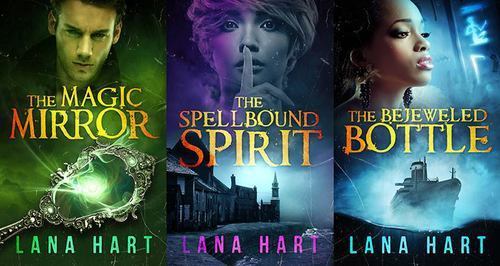
Now, I know what you're thinking: Lana, these are so much better than the originals! Why aren't they up already on Amazon???
Well, let me tell you my other exciting bit of news: both The Magic Mirror and The Spellbound Spirit are getting second editions!
The content isn't going to change much, so if you've read them already, you're not missing out. I took some reviewers' criticisms to heart, and after looking at both works critically myself, I made a decision to slightly alter a few passages. The basic plots remain the same, and major events will not change in any way. But just in case you're interested in the changes, I'll post a link to a quick synopsis once I've published both second editions.
This is all coming very soon, so make sure you stay updated so you don't miss anything! You can find me most often on Twitter, but my Facebook page stays fairly active, too.
That's it for announcements. But what about that update I was talking about?
The update I have is in regards to Kindle Unlimited, a new-ish program from Amazon that I urge you to check out my previous blog posts to learn more about. I have been consistently critical about what I consider the program's glaring flaws: the fact that authors have no idea what they're getting paid until after the fact due to a variable royalty rate, Amazon's distinct lack of transparency about the issue, and their history of screwing over self-published authors whenever it suits them.
I'm happy to report that for the past two months (January and February), Amazon's pay-per-borrow amount has stabilized somewhat at around $1.40. That's the good news.
The bad news is that we still have no idea what we'll see for March. As has been the case since its inception, we won't have any clue until April 15th. And Amazon is still pumping millions of dollars of their own money into the program each month. If they weren't, authors would literally get paid pennies for each borrow.
Which begs the question I've asked before: how sustainable is this, really? At what point will Amazon stop operating at a loss and let the pay-per-borrow rate fall? And since the program requires that authors publish their work exclusively on Amazon, and that those agreements lock us in for 90 days at a time, what assurance do we have that if/when the hammer falls, we'll be able to pull out in a timely fashion?
The put it simply: none. We have no assurance of this. Which means I'm still wary of the program in the long-term and that I'm still unhappy that authors are earning ~45% royalties from borrows as opposed to 70% royalties from actual sales (since borrows are no different from sales, as readers are paying for enrollment in the KU program).
But I'm cautiously optimistic. The fact that the rate of pay hasn't fluctuated wildly the past two months makes me think Amazon might be planning on keeping it at that level long-term. And if they were willing to lock it down for us, I would have far less reservations than I do now. I'd still have certain feelings about the lesser amount we're earning for what's essentially the same thing (sales vs. borrows), but knowing that I'm going to get paid $1.40 or so per borrow for as long as I'm enrolled in the program would be a step toward Amazon showing me that they respect me as an author. It would mean that Amazon wasn't holding all the cards in this deal and that they wouldn't be able to snatch their toys away at any time like the angry kid on the playground. And respect goes a long way with me, as I'm sure it does many others.
So, in short, things have improved on the KU front. I can only hope that with time, they continue to do so. This has the potential to be a great benefit to authors and readers alike. Let's just hope that Amazon decides to move in that direction rather than the self-satisfying one they've chosen in the past.
And as for The Curious Collectibles Series, it remains in the program for now, meaning you can still read The Magic Mirror and The Spellbound Spirit for absolutely FREE! If you're looking forward to the release of The Bejeweled Bottle, now's the time to catch up so you can dive right in as soon as it's out.
And remember to follow me on Facebook or Twitter for sneak peeks and special deals along the way (as well as ramblings, musings, and other fun stuff)!
November 14, 2014
Kindle Unlimited Screws Authors More Every Month
Okay, that title may seem a little dramatic. I assure you, however, that it's not.
If you've been following the numerous posts I've made about Amazon's Kindle Unlimited program, you know that I've regarded it with healthy skepticism at best and outrage at worst. I agreed to try the program for three months (since you must sell exclusively on Amazon during that time, a stipulation that is not applied to traditionally-published authors, only self- or independently-published ones) to see if Amazon would maintain its promise of approximately $2.00 per borrow, and when the first month paid out $1.80, I found my skepticism assuaged somewhat. At the time, it seemed like it was of great benefit to both readers and writers. For $10, you can read as many titles as you want, long or short, as long as they're enrolled in the program. That means that if a reader is strapped for cash, you can still reach them because to them, your book is "free."
Meanwhile, you make a tidy profit.
The next month, it dropped. The month after that, it dropped again to about $1.50/borrow. Despite Amazon funneling millions upon millions of dollars into the so-called "Global Fund" every month, they continued to pay lower and lower rates for borrows at a staggering rate, while also refusing to tell us what we'd be earning until the 15th of each following month. That means that whatever we earned in October would be up in the air until November. Specifically, until today.
Amazon fans who have had their blinders on have constantly assured me that I was panicking, that payouts wouldn't drop below $1.50, that Mother Amazon would take care of us all. Hopefully the figures released today will open their eyes.
For the month of October, KU's borrow rates plummeted to a measly $1.33/borrow. That's a full $0.20 less than last month's rate. Things aren't looking good for the holiday season.
Amazon has been deliberately opaque about the process and what authors are getting paid because they know the current model is unsustainable and completely unfair. For 90 days of exclusivity, you are rewarded with a pittance, a pittance with an ever-changing value, no less. You have no idea what you'll be earning month-to-month, and as Amazon has shown us now, they have no intention of settling anywhere near $2.00/borrow. We'll be lucky to see $1.00/borrow for November/December/January, peak buying months.
Why? Because as the number of KU enrollers rises, the profit margin diminishes. More and more people are subscribing, because to readers, it's a great deal. But that means Amazon has less money to dole out to authors, which means diminishing royalties for those of us who have signed a 90-day contract.
This results in hundreds, and sometimes thousands of dollars lost per author. Each month, the program itself results in paying out historic lows. The more people who enroll, the less the payout will be. Still, Amazon refuses to change the model, which means they're 100% A-okay with doling out royalties that will, at some point, be less than what traditional publishers pay.
Think I'm exaggerating? Let's say you decide to sell your novel on Amazon for $4.99. At a 70% royalty rate, you'll earn approximately $3.44 per unit after you take into account an electronic "delivery fee" that's about as bogus as it sounds (but that's a story for another time).
Meanwhile, if you're enrolled in KU, each borrow will pay out only $1.33 (or less, as time passes!), effectively instilling a royalty rate of 38%. That's just a shade over what most traditional publishing houses will pay you.
Which is about what Hachette was paying its authors, although Amazon was only too happy to paint Hachette as the bad guys for their 30% royalty rates.
And consider that Hachette prices its eBooks a little higher than $4.99. At this point, traditionally published authors are seeing higher royalty rates than authors enrolled in the KU program as long as they're charging $4.99 or more.
And they don't have to sign any exclusivity deal, either!
Some authors are catching on. HM Ward recently pulled her titles out of the program, stating that she hasn't been able to pay her son's medical bills due to the loss of money. Hugh Howey, the Amazon fanboy himself, pulled his lips away from their arse long enough to admit that he, too, was losing money in the deal.
For me personally, borrows make up 85% of my "sales," which means that my income fluctuates wildly depending on what Amazon decides to pay me that month. I've seen firsthand how it can take someone from four figures to three figures. And if you're a career author, that's not going to fly.
So, what can we do? We can demand reform. We can tell Amazon we're not going to take it anymore, and that they need to overhaul their broken system. We can expose Amazon's hypocrisy as they continue to try to shut down publishing houses while making themselves the new—and only—publishers around.
Like I predicted months ago, we're already in a position where Amazon's KU program is so strong that even pulling out of it wouldn't benefit us. Readers like paying $10/month for unlimited books. Taking away the ability to borrow our books will only hurt us more than a diminishing royalty program does.
I guess that what I'm saying is that at the end of the day, if Amazon takes our willingness to accept a pittance as payment as something they can extend to their non-KU royalty plans, then we'll have no one to blame but ourselves. Amazon is a company. Nothing more. Nothing less. It's those of us who acted like they were some kind of parental figure that are to blame.
Like the Lorax said: "Unless..."
Note: A previous version of this blog post listed the royalty rate for a $4.99 eBook under the Kindle Unlimited plan as 26%. It has been amended to reflect the correct amount of 38%.



